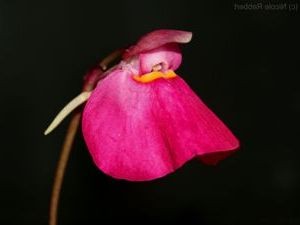Bladderwort
(Utricularia quelchii)

Description
Utricularia quelchii is a small perennial, epiphyte or terrestrial carnivorous plant that belongs to the genus Utricularia. U. quelchii is endemic to the Guyana Highland region of Guyana and Venezuela with one collection from Brazil. It was originally published and described by N. E. Brown in 1901. It grows on wet, mossy rocks or banks in swamps and around low tree trunks and branches and sometimes in the water-filled leaf axils of the bromeliad Brocchinia species. It is typically found at altitudes around 2,000 m (6,562 ft), but has been recorded from altitudes of 1,400 m (4,593 ft) to 2,800 m (9,186 ft), the highest collections representing specimens from Roraima. Utricularia, commonly and collectively called the bladderworts, is a genus of carnivorous plants consisting of approximately 233 species (precise counts differ based on classification opinions; a 2001 publication lists 215 species). They occur in fresh water and wet soil as terrestrial or aquatic species across every continent except Antarctica. Utricularia are cultivated for their flowers, which are often compared with those of snapdragons and orchids, especially amongst carnivorous plant enthusiasts. All Utricularia are carnivorous and capture small organisms by means of bladder-like traps. Terrestrial species tend to have tiny traps that feed on minute prey such as protozoa and rotifers swimming in water-saturated soil. The traps can range in size from 0.02 to 1.2 cm (0.008 to 0.5 in). Aquatic species, such as U. vulgaris (common bladderwort), possess bladders that are usually larger and can feed on more substantial prey such as water fleas (Daphnia), nematodes and even fish fry, mosquito larvae and young tadpoles. Despite their small size, the traps are extremely sophisticated. In the active traps of the aquatic species, prey brush against trigger hairs connected to the trapdoor. The bladder, when "set", is under negative pressure in relation to its environment so that when the trapdoor is mechanically triggered, the prey, along with the water surrounding it, is sucked into the bladder. Once the bladder is full of water, the door closes again, the whole process taking only ten to fifteen milliseconds. Bladderworts are unusual and highly specialized plants, and the vegetative organs are not clearly separated into roots, leaves, and stems as in most other angiosperms.
Taxonomic tree:







